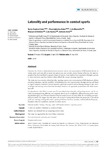Mostrar o rexistro simple do ítem
Laterality and performance in combat sports.
| dc.contributor.author | Ardá Suárez, Antonio | |
| dc.contributor.author | Dopico-Calvo, Xurxo | |
| dc.contributor.author | Iglesias-Soler, Eliseo | |
| dc.contributor.author | Morenilla, Luis | |
| dc.contributor.author | Giraldez-García, Manuel Avelino | |
| dc.contributor.author | Santos, Luis | |
| dc.date.accessioned | 2024-04-16T09:02:06Z | |
| dc.date.available | 2024-04-16T09:02:06Z | |
| dc.date.issued | 2016 | |
| dc.identifier.citation | Dopico-Calvo X, Iglesias-Soler E, Morenilla L et al. Laterality and performance in combat sports. Arch Budo 2016; 12: 167-177 | es_ES |
| dc.identifier.issn | 1643-8698 | |
| dc.identifier.uri | http://hdl.handle.net/2183/36211 | |
| dc.description.abstract | [Abstract]: Literature has shown a relationship between laterality and an over-representation of left-handed athletes in certain sports, and especially in sports one against one, such as judo, tennis, boxing or fencing; the main ex-planation has been attributed to greater chance of success. Some authors have explained it through a genetic or innate superiority hypothesis, however others defend the strategic advantage hypothesis. The study aim is an overview about laterality, sporting success, over-representation of left-dominant athletes executing techniques, and the possibility of modulating that over-representation through training and based on negative frequency-dependent selection hypothesis, given that in sports such as fencing, boxing or judo, tacti-cal designs and training actions have been developed based on the opponent’s predominant side while execut-ing skills. It is hypothesized that if there is some sort of relationship between laterality and sporting success, and the lat-erality executing sporting skills has been acquired, then it can be modified by different learning and/or train-ing methodologies; one of them is based on bilateral transfer processes of motor skills, but it is lacking on exper-imental research. We suggest that the notion of creating or making athletes from the perspective of the lateral preference running sporting skills and in sporting behaviours based on laterality, could modify the frequency-dependent selection hypothesis, especially in certain sports. | es_ES |
| dc.language.iso | eng | es_ES |
| dc.publisher | Archives of Budo | es_ES |
| dc.relation.uri | https://archbudo.com/view/abstract/id/11230 | es_ES |
| dc.rights | Creative Commons Attribution-NonCommercial 4.0 International | es_ES |
| dc.rights.uri | http://creativecommons.org/licenses/by-nc/3.0/es/ | * |
| dc.subject | Bilateral transfer | es_ES |
| dc.subject | Boxing | es_ES |
| dc.subject | Fencing | es_ES |
| dc.subject | Judo | es_ES |
| dc.subject | Left-handers athletes | es_ES |
| dc.subject | Sporting success | es_ES |
| dc.title | Laterality and performance in combat sports. | es_ES |
| dc.type | info:eu-repo/semantics/article | es_ES |
| dc.rights.access | info:eu-repo/semantics/openAccess | es_ES |
| UDC.journalTitle | Archives of Budo | es_ES |
| UDC.volume | 12 | es_ES |
| UDC.startPage | 167 | es_ES |
| UDC.endPage | 177 | es_ES |
Ficheiros no ítem
Este ítem aparece na(s) seguinte(s) colección(s)
-
GI-PHG - Artigos [75]






